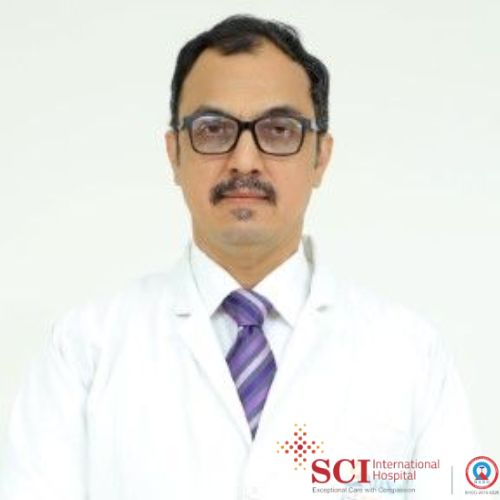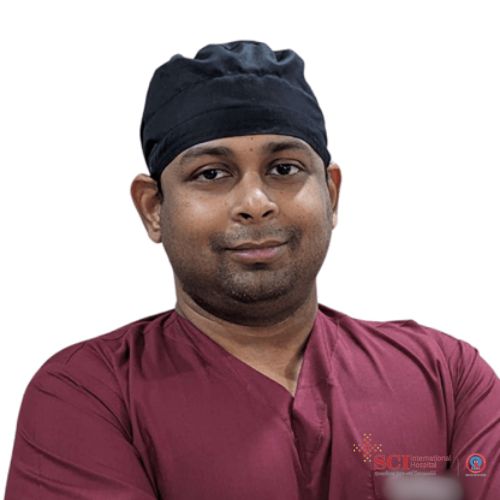Arthroscopic surgery is a minimally invasive way to diagnose and treat joint problems, especially in the knee and shoulder. Using small cuts and a tiny camera, doctors can see inside the joint and repair damaged ligaments, cartilage, or tendons without the need for large incisions. This means less pain, smaller scars, and faster recovery. At SCI Hospital in Delhi, expert orthopedic surgeons use the latest technology to provide safe, effective care and personalized rehabilitation plans, helping patients return to daily life with stronger, healthier joints.
We Are Rated
Consult Now
Arthroscopic surgery, often called "keyhole surgery," is a minimally invasive procedure used to diagnose and treat problems inside a joint. The name comes from the Greek words arthro (joint) and skopein (to look). A surgeon makes a few small incisions, each about the size of a buttonhole, around the affected joint. Through one incision, they insert an arthroscope—a thin tube equipped with a fiber-optic camera and light source.
This projects a magnified, real-time video of the inside of the joint onto a high-definition monitor. This clear view allows the surgeon to inspect the cartilage, ligaments, and other structures in great detail. If treatment is needed, specialized, pencil-thin surgical instruments are inserted through the other small incisions to repair, remove, or reconstruct damaged tissue. This technique avoids the need for a large incision, as is done in traditional "open" surgery.
Compared to traditional open surgery, which requires a large incision to open up the joint, arthroscopy offers significant benefits:
Arthroscopy can be performed on almost any joint, but the most common procedures involve the knee and shoulder.
Meniscus Repair
The meniscus is a C-shaped piece of cartilage that acts as a shock absorber between the thighbone and shinbone. Tears in the meniscus are very common. Depending on the type and location of the tear, the surgeon can either trim away the damaged portion (meniscectomy) or stitch the torn pieces back together (meniscus repair).
Cartilage Repair
Damage to the articular cartilage (the smooth lining covering the ends of the bones) can be addressed arthroscopically. Procedures can involve smoothing the damaged cartilage, stimulating new cartilage growth (microfracture), or transplanting healthy cartilage to the damaged area.
Arthroscopic Shoulder Surgery
The shoulder is a complex joint, and arthroscopy allows for precise treatment of its delicate structures.
Rotator Cuff Repair
The rotator cuff is a group of tendons and muscles that stabilize the shoulder. Tears can occur from injury or overuse. Arthroscopically, the surgeon can re-attach the torn tendon to the bone using small anchors and sutures.
Labral Tear Repair
The labrum is a ring of cartilage that surrounds the shoulder socket, enhancing stability. Tears, such as a SLAP tear or a Bankart lesion, can cause pain and instability. Surgeons can repair or trim the torn labrum arthroscopically.
Shoulder Impingement Treatment
This condition occurs when the space within the shoulder narrows, causing the rotator cuff tendons to be pinched. An arthroscopic procedure called subacromial decompression can be performed to remove bone spurs and inflamed tissue, creating more space for the tendons to move freely.
Preparing for Your Surgery
Before surgery, you will have a consultation with your surgeon to discuss the procedure. You may need pre-operative tests like blood work or an EKG. You will be instructed to stop eating or drinking for a certain period before the surgery and may need to stop taking certain medications, like blood thinners. It's important to arrange for someone to drive you home, as you will not be able to drive yourself after the procedure.
The Surgical Procedure Explained
On the day of surgery, you will be given anesthesia—this could be general (you're asleep), regional (your limb is numb), or local. The surgeon will make the small incisions, fill the joint with a sterile fluid to expand it and improve visibility, and then insert the arthroscope. After diagnosing the issue, the necessary repairs are made with specialized instruments. Once complete, the instruments are removed, the fluid is drained, and the small incisions are closed with stitches or sterile adhesive strips.
Your Recovery and Rehabilitation Journey
Recovery varies depending on the joint and the complexity of the surgery. After the procedure, your incisions will be bandaged, and you may be given a brace or sling. Most patients can go home within a few hours. Your surgeon will provide specific instructions for managing pain and swelling, often involving rest, ice, compression, and elevation (the R.I.C.E. method). Physical therapy is a critical part of recovery. A tailored rehabilitation program will help you regain strength, flexibility, and range of motion in the joint.
SCI Hospital stands out as a leading choice for arthroscopic surgery in Delhi for several important reasons:
Experienced Surgeons
Advanced Technology
Comprehensive Care
Patient-Centered Approach
SCI Hospital's commitment to excellence in orthopedic care makes it an ideal choice for your arthroscopic surgery needs.
Factors that Influence the Cost of Arthroscopic Surgery
The cost of arthroscopic surgery is not fixed and can vary based on several factors:
At SCI Hospital, we make sure you know exactly what you'll pay before any treatment starts, so you can decide what's best for you without any surprises. We give you a complete cost breakdown that shows every single charge, and we promise there won't be any hidden costs or unexpected bills showing up later. If you need help paying, we can set up payment plans that work with your budget. Our team also helps you deal with insurance - we'll get the approvals you need beforehand, help you fill out claim forms, talk directly with your insurance company, and explain exactly what they'll cover and what you might need to pay yourself.

MBBS, Diploma in Anesthesiology, MS - Orthopaedics, Orthopaedic surgeon, Joint Replacement Surgeon

MBBS, MS - Orthopaedics, Orthopaedic surgeon
Arthroscopic knee surgery at SCI Hospital is highly successful, with most patients experiencing significant pain relief and improved joint function. To know more about the success rate and to book an appointment, you can call us or consult online with our expert orthopedic surgeons.
The recovery time from arthroscopic surgery at SCI Hospital varies depending on the procedure, but our expert physical therapists will guide you through the recovery process. You can book an offline consultation with our physical therapists to know more about the recovery time for your specific procedure.
The scars from arthroscopic surgery at SCI Hospital are very small and fade significantly over time. Our surgeons use the latest technology to minimize scarring. To know more about the surgical procedure and to book an appointment, you can call us or consult online with our expert surgeons.
Arthroscopic surgery at SCI Hospital is considered very safe, but like any surgery, it carries some risks. Our surgeons will discuss these risks with you before the procedure. You can book an online consultation with our surgeons to know more about the risks and benefits of arthroscopic surgery.
To determine if you are a good candidate for arthroscopic surgery at SCI Hospital, our orthopedic surgeons will examine you and review your imaging tests. You can book an appointment by calling us or consulting online with our expert surgeons to know more about the procedure and whether it's right for you.
Consult Now
